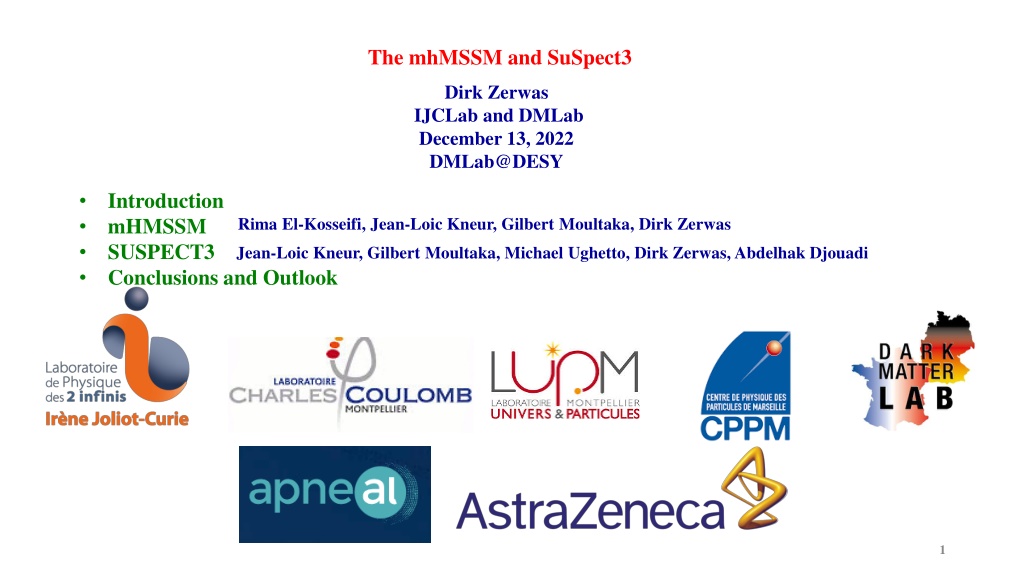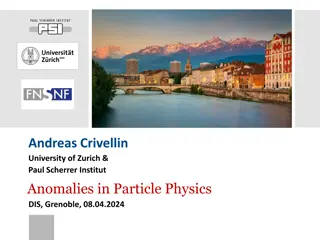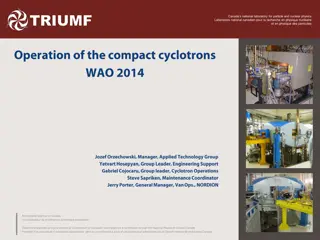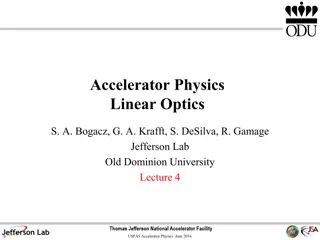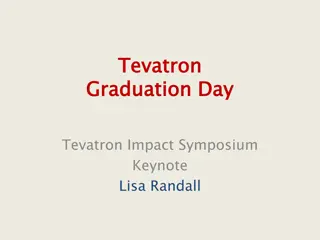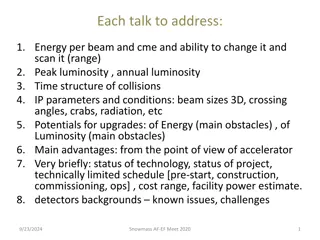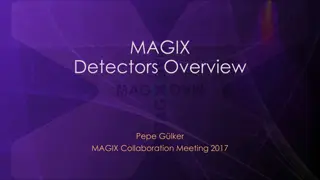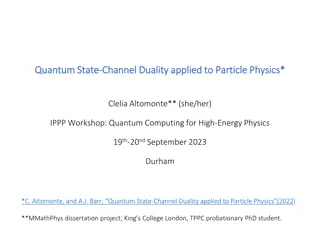Exploring the mhMSSM and SuSpect3 in Particle Physics
Explore the history and significance of the mhMSSM and SuSpect3 in particle physics, including the development of the MSSM, pMSSM, SuSpect calculator, and key discoveries like the R=+1 particle and relic density studies. Learn about supersymmetric particles, models like mSUGRA and NMSSM, and implications for LHC experiments. Delve into topics like R-parity conservation, the Stop Cliff phenomenon, and techniques for calculating supersymmetric spectra at the GUT scale. Discover the potential for new discoveries and advancements in understanding the fundamental particles of the universe.
Download Presentation

Please find below an Image/Link to download the presentation.
The content on the website is provided AS IS for your information and personal use only. It may not be sold, licensed, or shared on other websites without obtaining consent from the author. Download presentation by click this link. If you encounter any issues during the download, it is possible that the publisher has removed the file from their server.
E N D
Presentation Transcript
The mhMSSM and SuSpect3 Dirk Zerwas IJCLab and DMLab December 13, 2022 DMLab@DESY Introduction mHMSSM SUSPECT3 Conclusions and Outlook Rima El-Kosseifi, Jean-Loic Kneur, Gilbert Moultaka, Dirk Zerwas Jean-Loic Kneur, Gilbert Moultaka, Michael Ughetto, Dirk Zerwas, Abdelhak Djouadi 1
Introduction A brief history: 1997 GDR Supersymmetry (Pierre Binetruy) Working group MSSM 1997-2002 Definition of phenomenological MSSM (pMSSM) sfermions: 1stand 2ndgeneration universality No new sources of FCNC and CP violation 1999 Publication MSSM report: arXiv:hep-ph/9901246 (406 citations) 2002 Publication of Spectrum Calculator SuSpect: Comput.Phys.Commun.176:426-455,2007 Abdelhak Djouadi, Jean-Loic Kneur, Gilbert Moultaka pMSSM (of the MSSM WG +3 parameters), mSUGRA, mGMSB, . 2003 Susy Les Houches Accord (SLHA): JHEP 0407:036,2004 Interoperability of Spectrum, Decay and Cross section calculators 2012 Discovery a R=+1 particle: h 2013 Relic density MSSM with SuSpect2: Phys. Rev. D 89, 055017 (2014) 2013 Start on major rewrite in C++ (SuSpect3) 2015 Relic density NMSSM with SFitter: Phys. Rev. D 93, 015011 (2016) DMLab: SuSupect takes a SUSY-HIT started with Margarete Muehlleitner s talk at First DMLab Meeting: Scientific Kickoff 2022 Definition and implementation of the mhMSSM: Eur. Phys. J. C (2022) 82:657 2022 Publication of SuSpect3 (paper and manual): arXiv:2211.16956 2
Introduction fermion has no problems with radiative corrections (quadrat. div.) has a light Higgs Boson (<140GeV) interesting pheno at the TeV scale boson 3 neutral Higgs bosons: h, A, H 1 charged Higgs boson: H and supersymmetric particles Many different models: (p)MSSM (minimal supersymmetric extension of the standard model) mSUGRA GMSB AMB NMSSM spin-0 spin-1/2 spin-1 Squarks qR, qL q ~ ~ g ~ Gluino: g R-Parity conserved: Production of SUSY particles in pairs (Cascade-) decays to the lightest SUSY particle LSP stable, neutral and weakly interacting: neutralino ( 1) LSP candidate for CDM less than half of the particles observed Great hope for discovery due to LHC CM increase to 13.6TeV (Depeche Mode I can just can t get enough ) Sleptons: R, L h,H,A ~ ~ Neutralino i=1-4 Charginos: Z, H W i=1-2 3
The Stop Cliff An example point: Heavy squarks and sleptons Light LSP (Bino) Higgs mass: Experimental error ~ 0.15GeV Typical non-parametric error: 2GeV GeV level rounding: 125GeV Stop sector: Lightest stop at detection mass limit At=3610 GeV 4
Calculating a Supersymmetric Spectrum GUT scale ~1016GeV Boundary conditions: High scale: SUSY breaking masses EWSB scale: , m2A(EWSB) Z scale: tan Ae, A , Ad, As, Au, Ac Numerical solution of coupled RGE: High Scale to Low Scale in N steps RGE Ensure EWSB Iteration at EWSB scale RGE Derived: Radiative corrections EWSB scale: Higgs Potential Higgs and SUSY running masses to pole masses EWSB scale ~103GeV RGE Radiative corrections Z scale: Corrections to SM couplings (yukawa, W, Z Z scale ~102GeV 5
Measuring Unification: Eur.Phys.J.C71:1520,2011 SUSPECT3 High Scale MSSM, GMSB, mGMSB, AMSB, mAMSB mSUGRA, SUGRA INFLATION GUT scale ~1016GeV GUT scale ~1016GeV GUT scale ~1016GeV RGE RGE High scale ~1015GeV-106GeV High scale ~1015GeV RGE Inflation scale ~1014GeV RGE RGE RGE RGE RGE RGE Low Scale MSSM RGE EWSB scale ~103GeV EWSB scale ~103GeV EWSB scale ~103GeV EWSB scale ~103GeV RGE RGE RGE RGE Z scale ~102GeV Z scale ~102GeV Z scale ~102GeV Z scale ~102GeV MSSM: ~30 parameters scan Reduce parameter space by 1: mh replaces a parameter 6
Concept EWSB determines iteratively: Higgs mass parameter mu CP-odd running mass Atreplaced by mh Need to invert Higgs mass dependence on At Add the determination of At: Atdetermined from a pole mass Need all radiative corrections Can only be implemented post-EWSB Important: A spectrum calculation is iterative: RGE: high scale, low scale, Z scale EWSB 7
Proof of Concept -Approximate 1-loop Approximate 1-loop: At4 Local minimum: At= cotan Particularity of the benchmark: larger corrections 1-loop and 2-loop (with the Pietro Slavich terms): Structure preserved Non-negligeable contribution from 2-loop Inversion with approximate 1-loop: Invertible analytically 4 solutions for the stop cliff But: Atis off by 30% 8
Proof of Concept 1-loop Start from Eigenvalue equation: Identify the terms depending on At, eg in couplings h-stop-stop: Rewrite tadpoles and self-energies (0: log dependence): Eg in the one-loop scalar function (At in log term ignored) 9
Proof of Concept Leading to a new function: mh2enters C2, C1, C0, R1, R0 HiggsMolar: Exact 1-loop Similar form as the approximate 1-loop Zeros correspond to mh=125GeV Four solutions Formally At3 but 4 solutions: Function valid only in vicinity of solution EWSB modifies the pseudo-constants as function of At 10
Proof of Concept 1-loop and 2-loop Solve for At: Not possible analytically in general Step through the function in steps on 1MeV (just kidding) Transform Molar to a fixedPoint problem: CFPand LFP: Strong local dependence guides convergence But to converge need |LFP | < 1 (against repulsive FPs etc) Define convergence parameter and function: 2-loop (and higher orders): Enter in the mass matrix Soft dependence Remnants, log(At) and 2-loop: Taken into account exactly in the EWSB iterations EWSB iterations are standard also in standard MSSM! 11
Proof of Concept Full Algorithm EWSB: Not uniquely defined (see SLHA) mHu, mHd, sign( ) mA(Q), mA, Use reduced RGE precision Full Algorithm: 1. Stabilize top yukawa 2. Use approximate 1-loop inversion as first guess 3. EWSB: add fixed point iteration 4. Adapt tau locally Results promising: 0.1 permil precision reached on At (1permil set) mhexcellent (too good for practical purposes) Atprecision better than requested: effect of iterations It works: Similar precision achieved in all cases Stop condition is on for 2 cases 12
Proof of Concept: Beyond the benchmark point Proof of complete Inversion in more than 1 point: Stepping through mh Specifying s1, s2, s3, s4 Necessitates a stepper function applied regularly to identify the local minima and maxima in mh Close to extremal FP is complemented by a standard Bisection algorithm It works (better than expected): Regions are separated continuous Small steps corresponding to changes in pseudoscalar mass and leads to a <2GeV deviation in mh 3 points (of 256) not converged Eur. Phys. J. C (2022) 82:657 Inversion works: from mh(At) to At(mh) Now the implementation: SUSPECT3 13
EWSB Variant 1: m2Hu m2Hd sign( ) At, . Determine: m2A(EWSB) Variant 2: m2A(EWSB) At, Determine: m2Hd m2Hu Variant 3: mA At, Determine: m2Hd m2Hu Variant 6: mA mh, Determine: m2Hd m2Hu At(EWSB) Variant 5: m2A(EWSB) mh, Determine: m2Hd m2Hu At(EWSB) Variant 4: m2Hu m2Hd sign( ) mh, Determine: m2A(EWSB) At(EWSB) Eur. Phys. J. C (2022) 82:657 Jean-Loic Kneur @CosPT 14
C++ Inheritance: Models and EWSB Models: Base for initialization Generic bottom up running Generic models as function of the number of scales (up to 5) Generic models implement the algorithm: RGE running Calculating rad corrs at the right scale Calculating pole masses Specific models implement boundary conditions (set the SUSY breaking parameters) Minimal models inherit from larger models of the same type EWSB Base for initialization 3 classes EWSBclassic Base Algorithm specific part m2Hum2Hd , mA2(EWSB) (BC at 3 scales) , mA 1 class EWSBmh Base mh EWSBclassic+EWSBmh Alg developed for 1 EWSB variant, worked for all 3 Difficulty: diamond inheritance (virtual solved the problem) Examples: Base 2scales LowScaleMSSM Base 4scales GMSB mGMSB Base 4scales AMSB mAMSB . 15
Upgrades wrt SuSpect2 and Technicalities Upgrades: EWSB decoding automatic EWSB with Higgs inversion Closer to respecting full SLHA specifications: EXTERNAL Block index 0: non standard in SuSpect2, now standard treatment 1stand 2ndgeneration sfermion parameters separated Complete rad corr Charginos Neutralinos calculated on pole masses instead of previous approximations Kept SLHA+ capability of fixed EWSB and GUT scales Implemented inflation model Testing: Comparisons with SuSpect2 (will be maintained) Compilation gcc 4.8.5 and 8.1.0 with severe flags (well kind of) Checked all example Models with valgrind Availability: v3.1.0 http://suspect.in2p3.fr wget http://suspect.in2p3.fr/tar/suspect3.tar.gz tar xvfz suspect3.tar.gz ./configure make suspect3 d examples/mSUGRA.in Code maintenance: Started with disk Moved to svn@LAL Moved to gitlab.in2p3.fr Implemented CI tests for example files 16
Conclusions and outlook Proof of concept: mhas fundamental parameter of the MSSM: doable Correct to all orders Stop cliff benchmark: works 1d scan: works SuSpect3: Excellent collaboration between theorists and experimentalists lead to: Major rewrite of SuSpect Support for more models New variants of EWSB Future work: Part of the DMLab projects: work with SUSYHIT Improvements on the Higgs Inversion 17
